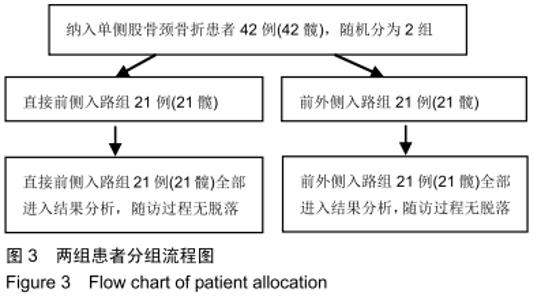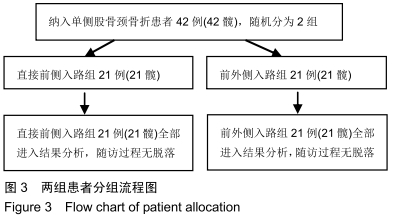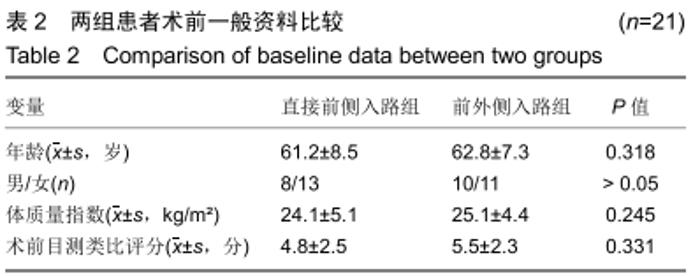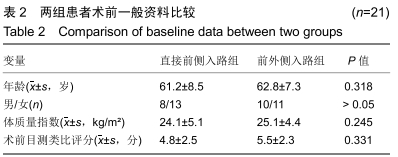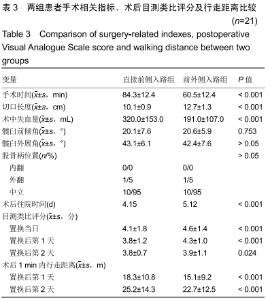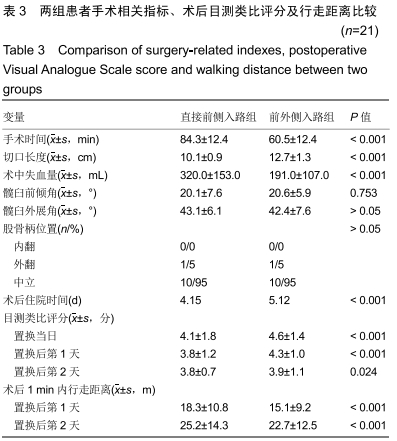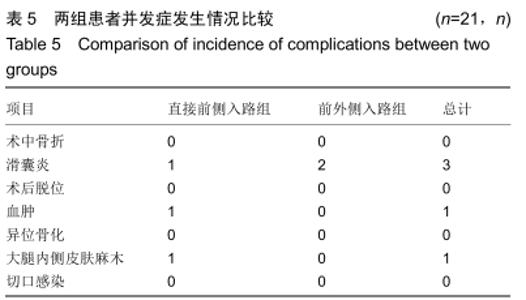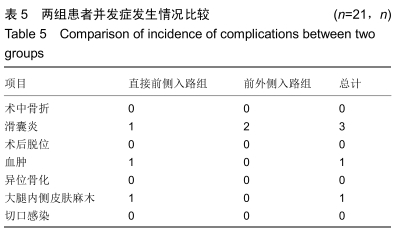[1] LAUPACIS A, BOURNE R, RORABECK C, et al. The effect of elective total hip replacement on health-related quality of life. J Bone Joint Surg Am. 1993;75-A(11):1619-1623.
[2] 周加平,吉光荣.微创人工全髋关节置换术手术入路研究现状[J].骨科临床与研究杂志,2017,2(3):186-188.
[3] BERGER RA, JACOBS JJ, MENEGHINI RM, et al. Rapid rehabilitation and recovery with minimally invasive total hip arthroplasty. Clin Orthop Relat Res. 2004;429-239.
[4] WILLIAM H, TROUSDALE, BA, MICHAEL J, et al. Patient perceptions of the direct anterior hip arthroplasty. J Arthroplasty. 2017;32 (2017) 1164-1170.
[5] KYRIAKOPOULOS G, POULTSIDES L, CHRISTOFILOPOULOS P. Total hip arthroplasty through an anterior approach: the pros and cons. EFORT Open Rev. 2018;3(11):574-583.
[6] NILSDOTTER A, BREMANDER A. Measures of hip function and symptoms: Harris Hip Score (HHS), Hip Disability and Osteoarthritis Outcome Score (HOOS), Oxford Hip Score (OHS), Lequesne Index of Severity for Osteoarthritis of the Hip (LISOH),and American Academy of Orthopedic Surgeons (AAOS) Hip and Knee Questionnaire. Arthritis Care Res (Hoboken). 2011;63 Suppl 11:S200-207.
[7] KALAIRAJAH Y, AZURZA K, HULME C, et al. Health outcome measures in the evaluation of total hip arthroplasties—a comparison between the Harris hip score and the Oxford hip score. J Arthroplasty. 2005;20(8):1037-1041.
[8] MATTA JM, SHAHRDAR C, FERGUSON T. Single-incision anterior approach for total hip arthroplasty on an orthopaedic table. Clin Orthop Relat Res. 2005;441:115-124.
[9] POGLIACOMI F, PARASKEVOPOULOS A, CONSTANTINO C, et al. Influence of surgical experience in the learning curve of a new approach in hip replacement: anterior mini-invasive vs. standard lateral. Hip Int. 2012;22: 555-561.
[10] MARTIN C, PUGELY A, GAO Y, et al. A comparison of hospital length of stay and short-term morbidity between the anterior and the posterior approaches to total hip arthroplasty. J Arthroplasty. 2013;28:849-854.
[11] ZAWADSKY M, PAULUS M, MURRAY P, et al. Early outcome comparison between the direct anterior approach and the mini-incision posterior approach for primary total hip arthroplasty: 150 consecutive series. J Arthroplasty. 2014;29:1256-1260.
[12] JELSMA J, PIJNENBURG R, BOONS H, et al. Limited benefits of the direct anterior approach in primary hip arthroplasty: a prospective single centre cohort study. J Orthop. 2017;14:52-58.
[13] ZAWADSKY MW, PAULUS MC, MURRAY PJ, et al. Early outcome comparison between the direct anterior approach and the mini-incision posterior approach for primary total hip arthroplasty:150 consecutive cases. J Arthroplasty. 2014;29(6):1256-1260.
[14] SMITH TO, BLAKE V, HING CB. Minimally invasive versus conventional exposure for total hip arthroplasty: a systematic review and meta-analysis of clinical and radiological outcomes. Int Orthop. 2011; 35(2):173-184.
[15] JEWETT BA, COLLIS DK. High complication rate with anterior total hip arthroplasties on a fracture table. Clin Orthop Relat Res. 2011; 469(2): 503-509.
[16] WOOLSON ST, POULIOT MA, Huddleston JI. Primary total hip arthroplasty using an anterior approach and a fracture table: short-term results from a community hospital. J Arthroplasty. 2009; 24(7):999-106.
[17] BREMER A, KALBERER F, PFIRRMANN C, et al. Soft-tissue changes in hip abductor muscles and tendons after total hip replacement. J Bone Joint Surg Br. 2011;93: 886-889.
[18] MJAALAND K, KIVLE K, SVENNINGSEN S, et al..Comparison of markers for muscle damage, inflammation, and pain using minimally invasive direct anterior versus direct lateral approach in total hip arthroplasty: a prospective, randomized, controlled trial. J Orthop Res. 2015;33:1305-1310.
[19] BERGIN P, DOPPELT J, KEPHART C, et al. Comparison of minimally invasive direct anterior versus posterior total hip arthroplasty based on inflammation and muscle damage markers. J Bone Joint Surg. 2011; 93:1392-1398.
[20] JEWETT B, COLLIS D. High complication rate with anterior total hip arthroplasties on a fracture table. Clin Orthop Rel Res. 2011;469-503.
[21] LEE G, MARCONI D. Complications following direct anterior hip procedures: costs to both patients and surgeons. J Arthroplasty. 2015;30:98-101.
[22] DE STEIGER R, LORIMER M, SOLOMON M. What is the learning curve for the anterior approach to total hip arthroplasty? Clin Orthop Rel Res. 2015;473: 386-396.
[23] TAMAKI T, JONISHI K, MIURA Y, et al. Cementless taperedwedge stem length affects the risk of periprosthetic femoral fractures in direct anterior total hip arthroplasty. J Arthroplasty. 2018;33:805-809.
[24] CIDAMBI K, BARNETT S, MALLETTE P. Impact of femoral stem design on failure after anterior approach total hip arthroplasty. J Arthroplasty. 2018;33:800-804.
[25] POST ZD, OROZCO F, DIAZ-LEDEZMA C, et al. Direct anterior approach for total hip arthroplasty: indications, technique, and results. J Am Acad Orthop Surg. 2014;22(9):595-599.
|
